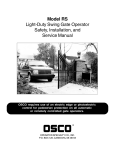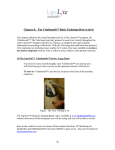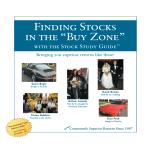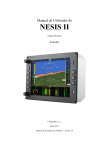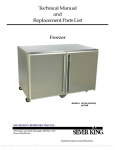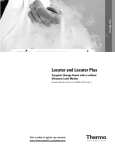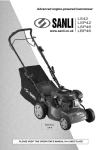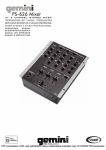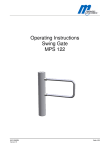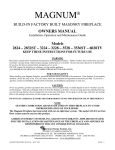Download Vol. 8, No. 4, 1966, 20pp
Transcript
PDF compression, OCR, web optimization using a watermarked evaluation copy of CVISION PDFCompressor
Earle Eckel may have been wondering, "Why
would anyone in his right mind ever quit flying
autogiros and get tangled up with restoring steam
cars?", when this photo was taken several years
ago in his airplane hangar in New Jersey. But retore it he did, and to pristine condition. The car,
a 1908 Stanley 20 H.P. Model F, now belongs to
Bob Lyon. It appeared on the Spring, 1964 cover
of the Steam Automobile.
S. S. MINER, Editor
T.A. HOSICK,
Technical Editor
Contents
ARTICLES and FEATURES
— Bill's Potato Steamer, by William J. French
— Keep 'em Steaming
— Philadelphia Steam Session, by R. L. Lyon
— Low Smog
— Out of the Archives
— Elliptocline Progress, by T. A. Hosick
— Future Steamer?, by W. D. Thompson
— Two Composite Steamers
4
6
6
7
8
13
16
17
WELCOME, SWEET SPRINGTIME
Is it naive to think that the steam automobile
can make a comeback? This depends upon a lot of
things. To begin with, it depends upon what is meant
by a comeback. If by this word, it is meant that a
manufacturer like Ford will stop making internal
combustion engines and start making steam engines
for their cars, it is probably pretty naive. From their
point of view it would probably seem nutty, quite
irrespective of the merits of steam as a means of
propelling automobiles. What would they do with
all that machinery that has no use except to make
internal combustion engines ? And their engineers —
how to retrain them in the thermodynamics and
mechanics of steam? One shudders at the thought.
Their answer to any threat to internal combustion
is bound to be to correct and improve it, not abandon
it — and this is just what they are trying to do to
combat smog.
Of course smog is a real problem, and the large
automobile manufacturers, among other things,
have done a certain amount of talking about electric
cars. They have even put together a couple of battery-powered vehicles to show the reporters, who
have looked and then dutifully trotted back to their
The STEAM AUTOMOBILE is published quarterly by and
for the Steam Automobile Club of America, Inc., a nonprofit organization d e d i c a t e d to the preservation of
steam car history, the restoration of antique steam cars,
aiding the development of a modern steam car, and interesting the manufacturers in producing a modern steam
car. The STEAM AUTOMOBILE will accept for publication
suitable material dealing with subjects which fall within
the above areas. Address all communications regarding
editorial matter or advertisements to: Editor, The STEAM
AUTOMOBILE, 1937 E. 71st St., Chicago, Illinois 60649.
Include zip code number with all return addresses.
MISCELLANY
— Antique Fire Engine
7
— "Thermodynamics" Errata, by T. A. Hosick 13
— More Dobles
12
— Ohio SACA Luncheon
14
— I.C. Headaches
14
— Notice to Engine Rebuilders
19
— Steam Exposition
19
— SACA Meet Notices _ _ _ _
_
_ 19
typewriters to tell about the wonders they have seen.
Behind his smog screen, there has undoubtedly been
some frenzied head-scratching, but out of it no production forecasts on electric cars have emerged.
There is, however one manufacturer who has announced production of an electric car, with a 25 mph
speed and a 50 mile range. Not an automobile manufacturer though; it's Westinghouse. Obviously any
trend that increases the consumption of electric power and paraphernalia is all to the good for them;
they have no particular stake in the internal combustion engine.
Well, if by a steam comeback it is meant that
someone other than an established automobile manufacturer will produce a steam car, is this naive ? Perhaps not so much so, but now other questions must
be asked, such as, how many cars constitute a comeback? And also, can technical problems be solved?
Will a sufficient number of people want the cars? To
these last two questions, steam men will answer
"yes", and as for the number required, probably
even one brand-new steamer would be hailed as a
comeback. And so, naive or not, steam men, cogitating new steam developments, look forward optimistically to Spring.
OFFICERS
ROBERT L. LYON
R . A . GIBBS
A . W . LANDRY
-
. . .
President
. . . .
Vice-president
. . . .
Secretary
PDF compression, OCR, web optimization using a watermarked evaluation copy of CVISION PDFCompressor
the effort you have put forth in time and money to keep
this club going. I am quite sure that without your efforts
the club would have folded long ago.
Sincerely,
Al Reynolds
Dear Bob:
I enjoyed your letter. Bob, I really do appreciate your
efforts. Maybe one of these days I'll be able to spend
some time for STEAM which I was brought up on and
in which I've never lost interest. Hope that 1967 will
bring that steam car you've worked so hard for.
Sincerely,
Charlie Bullen
Dear Sirs:
Keep up the good work. Were it not for your efforts
there would be no Steam Club today.
Glendale, Calif.
Dear Sir:
Am really very grateful for all you have done and
are doing for the Club. I'm sure all the members feel
the same way. Hope you will be able to carry on the
good work. I don't think anything can take the place of
steam.
Very truly yours,
John S. Cannon
Mr. Lyon:
Thank you for your efforts on behalf of the membership of the club. While I have no steam apparatus with
which to tinker, I do have considerable interest in new
and old steam autos. I have found the magazine to be
a source of valuable information in What's Doing in
Steam, and look forward to each issue, eagerly. Again,
I'd like to express my appreciation for your special attention to advancement of our special interest — STEAM.
Yours truly,
Patrick McNulty
Dear Bob:
Just a vote of confidence and appreciation for your
efforts in behalf of the Club in any schism. Best wishes!
Carl E. Barrett
New York
Dear Sirs:
Enclosed is my renewal to your wonderful magazine.
Would have liked to have been able to attend one of
the meets, but so far there hasn't been one close enough.
My ambition has been to pick up a unit that I could rebuild and build the body for.
Best wishes.
S. George Barker
Saskatchewan, Canada
Dear Bob:
I am not aware of what may have caused you to
write the letter enclosed with the dues notice. I assume
their has been some criticism somewhere along the line.
For my part I want you to know I fully appreciate
Mr. Roy Ferrier, Chairman,
Western Region, SACA
Dear Mr. Ferrier:
Nov. 28, 1966
It was with pleasure that I received my copy of the
resolution urging strengthening of the SACA and the
magazine, Steam Automobile.
As a publisher of a weekly newspaper and a monthly tourist-oriented tabloid, I am aware of some of the
problems in publishing which are not apparent to the
subscriber. At the same time I am aware of the pitfalls
of hobby groups, particularly the tendency to become
socially rather than hobby oriented. It is something that
must be fought continuously by those interested in the
creation of (in our case) successful innovations in steam
engines.
I have always sincerely regretted the "split" which
sent several members out of the group. Their enthusiasm
and knowledge could both be of great benefit to SACA
. . . and there isn't room for two strong magazines. However, I feel it is impatience with the items mentioned in
your letter that caused this to occur.
Many of us of the hobby are not competent to work
on the same level of yourself nor on the scale of some
of the wealthier ones, but our little 10-20-30 horsepower
rigs are dear to our hearts . . . Busy men find little time
to write and knowledgeable men don't realize the importance of "kindergarten articles" . . . nor do antique
lovers have any respect for our compressor, IC or outboard conversions. (I for one, respect their efforts but
find it improbable that I will ever have the wherewithall
to own an antique).
I would dearly love detailed descriptions of the individual components of, for example, the Frostline buggy illustrated in the last issue, and other home-made
vehicles, so that I might have a base on which to consider my ideas for improvement. If I succeed in my aim
of partial retirement, I hope to be able to visit the Los
Angeles area and offer my help.
Best of luck to you in your chairmanship.
Sincerely,
Allen D. Reed, Oregon
Dear Bob:
January 9, 1967
Enclosed is my check for my dues.
I want to thank you taking the bull by the horns, to
remedy the mess caused by a very few members who
must be power mad, trying to kill our wonderful club,
or to eliminate those of us who are interested in a modern steam car. I hope this will be the end of trouble, so
we can enjoy our meets.
The San Diego meet for the most part was very enjoyable, possibly due to the extra energy and the true
loyalty of Hyden Taliaferro and his helpers. My wife
(Continued on Page 15)
PDF compression, OCR, web optimization using a watermarked evaluation copy of CVISION PDFCompressor
ONE
MAN'S
ANSWER
TO:
"-
WISH
I HAD A
STEAMER-"
By William J. French
photos by the author
Mr. French entering his "Potato Steamer". Photo taken
in Posen Potato Festival Parade. Note 70 PSI steam on
gauge.
The chassis of my car is a Crosley in which I
cut the differential housing open, in order to use a
chain drive, and put on a sprocket instead of a ring
gear. Using the rest of the frame and four wheel
brakes gave me a good start.
Next, I mounted a 2½ x 3½" double cylinder
car engine and hooked it directly to the axle with a
roller chain at a 2½ to 1 ratio.
By then, I had my boiler built to my own design.
You will note in the picture how I put it together.
I used 11 114" tubes 18" long on each side welded
to a l¼" pipe 21" long, top and bottom, and welded
connections to the side of the tank which was made
from the bottom end of a large oxygen cylinder,
which I cut 21" long also; then, welded a plate in
where you see the water glass. I also had about 30
foot of 1/2" pipe coiled between the 2 side sections,
which was connected across the bottom at back, too,
for circulation of water.
I then put it to a cold water test of 300 lbs.,
which proved to be O.K., so I enclosed it with a steel
jacket lined with asbestos.
The boiler held 5 gallons of water at half-glass
and I could get steam in 7 minutes, using bottled gas
for fuel. The burners were like gas stove oven burners with 3 units, and control valve was near the
steering wheel, easy to operate.
I set the safety valve at 105 lbs. Forty lbs. would
run the car, but 80 to 100 lbs. was a lot better. My
top speed was 20 miles per hour. The exhaust of the
engine was piped through a 12 gallon water tank to
heat the water and this pipe was about 14 of a tank
from the bottom. You see, by the time I used water
that low, it was nearly too warm for the pump to
operate good.
Twelve gallons of water would last about 3 hours
and 25 lbs. of bottled gas would last the same
amount of time.
The engine had a cross head water pump and an
oil pump for cylinders. I also had a hand pump if I
needed it.
Fire box end of the converted Crosley steamer.
PDF compression, OCR, web optimization using a watermarked evaluation copy of CVISION PDFCompressor
Mr. French in the Crosley in front of his shop. Weight of
this car is 1150 lbs. — it will do 20 MPH. Note the headlight, an oil-burning lamp from an 1899 auto.
The 3-wheeler hitched up for towing.
The little car had 3 whistles and handled just
like a locomotive. The reverse lever, the throttle and
water valve, as well as the gas was easy to operate.
Everything was manual control — NO automatics.
I wanted something to drive and operate. It was
a pleasure just to notice the water steam and do a
bit of adjusting once in a while. I had lots of time
to greet and wave at people while driving through
parades. But I liked to drive it better without the
top on. When I was in a parade at Traverse City, at
their Cherry Festival, some people said it must run
on an electric battery because it didn't make any
noise. But the whistles surely did.
Last June, due to ill health, I sold this car to a
man in Holly, Michigan, but after recovering, I
started another.
I acquired a flueless boiler and a mill-type engine
2" bore and 4½" stroke. Had to make a reverse,
which I did. I then started with a 3 wheeler in mind,
so I could just take off the one wheel and put on a
hitch and tow it anywhere. I made the frame out of
pipe, mounted boiler and engine, and also the transmission, a water tank and a coal bunker, plus a few
trimmings, and I was ready for the Posen Potato
Festival Parade. I used some old Norway pine knots
and some coal. The old timers like to smell pine
and a little steam oil mixed.
I used a U. S. injector on this rig, and everything
worked fine. My picture was in the Alpena News
and also in the Detroit News Sunday paper of October 10, 1965.
Some people liked it better than the Crosley because they could see everything working, but it
didn't handle as easily with only one cylinder.
A friend of Mr. French's boarding the 3-wheeler. This
machine weighs 1550 lbs., will do about 12 MPH on
90 lbs. of steam.
PDF compression, OCR, web optimization using a watermarked evaluation copy of CVISION PDFCompressor
SPECIAL STEAM
SESSION
Philadelphia, February 18, 1967
By R. L. Lyon
SETTING THE VALVES ON
THE MODEL 735 ENGINE
(Reprinted from the Stanley Dealer
Bulletin for May 18, 1922)
The model 735 engines starting with engine
#2098 have the valves marked 735 and are stamped
with an arrow which points to the front of the car
when they are properly installed.
Before setting the valves, see that the engine is
hooked up with one of the cranks on center. Clamp
the hook-up dog to the quadrant to prevent it from
slipping out when turning the engine over. On the
side of the engine where the crank is on center, there
should be 2 5/16" distance from the center of the
link hanger rod pin to the center of the link block
pin. In case this distance varies, it will be necessary
to bend the hook-up quadrant either forward or
back to make the distance between these points
2 5/16". This determines the proper amount of hookup. Check up both sides and be sure that they are
practically the same.
The valves are set by the maximum port opening and not by the amount of lead. In revolving the
crank, always turn the engine the same way as it
turns in the car while going forward.
Set the valve to admit steam to the front end of
the cylinder when the crank is in a position over the
forward center 4 9/16" measuring from the center
of the crank pin to the top edge of the top frame
rod, as the engine sets in the vise. This operation is
necessary for the setting of each valve.
After the engine has been hooked up and the
cranks properly set, the valve stem can be turned
so as to give the maximum port opening on the front
end of the valve .100" opening.
When this setting is obtained, the opening at the
rear of the valve should be approximately .140"
which is correct for the rear, though it can vary
slightly. In this position, with the valves properly
set, the lead when hooked up from dead center
should be approximately .040" at the head end,
and .085" on the crank end. Both valves should
be set at the head end only and by the maximum
port opening. The usual method to handle the engine
for repair work, especially valve setting, is to turn
it bottom side up and set it in a vise, and by removing the steam chest cover, this will give free access
to the valves.
As a result of many letters and phone calls to
Steam Automobile Club Headquarters a special
steam session was held at the Bellevue-Stratford
Hotel in Philadelphia, concurrent with a regular
AACA meeting.
AACA members who also belong to SACA (or
who are merely interested in steam) as well as several SACA members, attended the session and derived both pleasure and useful information from the
several talks given. Those who are restoring antiques
got useful pointers in maintaining authenticity in
their machines, while of more general interest were
the talks on modern steam.
Earle S. Eckel gave very thorough instruction
on various types of pumps and the year and model
to which each belongs. He gave similar information,
as well, on steam and fuel automatics, and showed
examples of them. Gauges were given consideration
too, along with the names and addresses of places
that would authentically restore them.
Richard W. French gave full instructions on
building and refueling Stanley boilers, including
specifications for the materials required and other
details. He also displayed a complete set of tools for
doing the work. Of special interest in his talk was a
new method of rolling in the flues, rather than swaging them in, as has been the usual way. The materials making up the equipment for rolling in the
flues were, for the most part, obtained from military
surplus stores. The rollers alone were new — the
electric motor, flexible shaft and other items were
all surplus. On the flexible shaft incidentally, was a
clutch which he had himself designed and made. To
this, was attached the roller fitted with a depth stop.
The clutch was adjustable so that the tube would
not be over expanded, nor could the roller stick in
the tube and damage the boiler plate.
R. A. Gibbs and Thomas A. Hosick of North Carolina spoke on their many experiments with check
valves and water pumps. They also displayed a modern water pump they have designed, which can replace the original pumps of steam cars should authentic pumps become unavailable. It can also be
used for other pumping applications. In the afternoon they showed slides of their modern steam power plant and said they expected to have the complete
chassis to demonstrate at the steam meet at Greensboro, North Carolina May 5-6-7, 1967.
The Williams brothers of Ambler, Pennsylvania,
described at length the two day smog test given their
modern steamer at a major oil company test plant
in New Jersey. Further details on this will be found
in an article on the next page.
PDF compression, OCR, web optimization using a watermarked evaluation copy of CVISION PDFCompressor
LOW SMOG OUTPUT
SHOWN BY WILLIAMS
STEAMER IN TEST
Steam car owners have always known that their
cars do not produce the variety of fumes that an internal combustion-driven cars do. But this never
seemed really important, except esthetically, considering the immensity of the atmosphere into which
the waste gases could be diffused. That this supposition was false, has been emphatically underlined by
the growing smog problem in densely populated
areas, particularly where climatic conditions have
occasionally permitted contaminants in the atmosphere to rise to acute and intolerable levels.
Research into the causes of, and possible cures
for, smog has therefore become a very active field
of inquiry, and those involved are exploring every
likely avenue. So at last, and quite possibly for the
very first time, a series of tests has been run making a direct comparison between the smog output of
a steam-powered automobile and an I.C. automobile.
The tests were run at the Mobil Oil Company
testing laboratory, Paulsboro, N. J., at the request of
one of the worlds largest automobile manufacturers.
The two cars tested were a 1966, 6-cylinder sedan
produced by the manufacturer mentioned (who desires to remain anonymous for the present) and the
Williams 4-cylinder steamer. The Williams car was
the same one that has been seen at several SACA
meets, and ridden in by many SACA members.
The tests, run in January, required two complete
8-hour days for their completion, being what are
called the California Cycle Test, and the Federal
Smog Test. It should be pointed out that these tests
are not merely a matter of placing an engine on a
test block and attaching a few instruments, as one
might suppose. Complete vehicles are used. The car
is placed on a device called a General Electric Chassis
Dynamometer, the rear wheels running on a four
foot diameter drum. The drum is connected to an
electric dynamometer recording the actual horsepower output of the car at the surface of the tires,
where they bear against the road. Speed is measured by means of a fifth wheel running against the
drum, the car's speedometer not being relied upon.
The complete rig, car and all, is enclosed in an airconditioned room. Any climatic condition can be
duplicated. Air flows through the room, against the
front end of the car, at a velocity corresponding to
the indicated road speed. Braking effort can be applied to the drum to simulate the load conditions of
a hill-climbing. Instruments measure and record all
engine and combustion conditions.
The results of these tests were spectacular. The
Williams steamer not only produced fewer contaminants than the I.C. car, which was fitted with a
smog-suppressing device, but the margin between
the two was so great as to make it appear doubtful
that an I.C. car can ever equal a steamer in this particular. An ordinary I.C. car, without a smog-suppressor, emits from 800 to 1,000 parts per million of
hydrocarbons (among other contaminants) in its exhaust. With a suppressor, hydrocarbon emission can
be brought down to about 275 ppm, the figure reached by the 6-cylinder test car.
Hydrocarbon output of the Williams car, however, varied between 30 and 40 ppm in the test. The
275 ppm reached by the I.C. car is just barely at the
level which will be permitted by Federal law in 1968
on new cars. But the state of California, where smog
conditions are the worst, will require that new cars
emit no more than 170 ppm, by 1970. This leaves
I.C. engine builders with a serious, and as yet unsolved, problem. On the other hand, according to the
Williams brothers, performance of their steamer, in
regard to smog production, can be made even better
than it was in the test.
The emission of contaminants other than hydrocarbons, and other performance characteristics of
the two cars, were also measured in these tests.
At this writing, complete data is not at hand,
but it is expected that these figures will be made
available for publication in the near future. When
they are, a complete report will be prepared for
readers of the Steam Automobile.
Mr. and Mrs. Earle Eckel, vacationing in Florida,
sent this post card picturing a 1906 American
La France fire engine, which is in a museum at the
Edison Winter Home in Fort Meyers, Florida. Earle
has his own museum back in Washington, New
Jersey, and has an engine almost exactly like this
one in it, among many other steam items.
PDF compression, OCR, web optimization using a watermarked evaluation copy of CVISION PDFCompressor
Reprinted from the September, 1907 issue of "The Steam Motor Journal"
THE SIMPLEX ROTARY
STEAM ENGINE
There has been invented, and just perfected, a
wonderful improvement in steam engines. This is a
perfect high and low pressure, full expansion, steam
tight, reversible, easily and positively adjustible rotary steam engine. The engine will be known as the
Simplex Rotary Steam Engine, and is the invention of
Mr. Peter English, of Colorado, who has devoted a
great deal of time, energy and mechanical skill to
solving the problem of this very desirable new principle in the application of steam as a motive power.
The engine is owned and controlled by the Simplex
Engine Co., with offices at 423 Commonwealth Building, Denver, Colorado. Many have tried and failed
in their efforts to bring out a rotary steam engine
which was a success, the objections being that it was
impossible to compensate for wear and produce a
steam tight engine with wearing surfaces reduced to
a minimum and also a method of giving support for
the steam in its back pressure when undergoing expansion.
In the new rotary steam engine compensation for
wear has been allowed for, and by a simple adjustment of a screw may be taken up. Heretofore, other
forms of rotary steam engines showed excellent results when new, but their life was very short, for as
soon as a little wear took place they were no longer
steam tight, and the engine became useless. These
things have all been overcome in the Simplex Rotary
Steam Engine, and in a very simple way. When one
understands how it is done you wonder why some
American genius has not accomplished the same
result before. In the construction of this rotary engine it is perfectly steam tight at all points, and maintained so by means of positively adjustable parts.
There are no friction wearing surfaces to cause loss
of power, and their claim is that friction is reduced
to only 3.17 per cent in the simplex as against 11 per
cent in the reciprocating engine. There are no dead
centres, no gears, and only few moving parts, being
only 3, and an engine of high horse power occupies a
very little space, much less than that of the reciprocating engine of the same power. This is one of its
great advantages as an automobile and marine engine.
It is simple, and the cost of construction will be much
less than the ordinary reciprocating engine.
In its operation there is no vibration, as all the
parts are perfectly balanced. It runs in a perfectly
true circle, and can be operated from 10 to 4,000 revolutions per minute, being noiseless in its operation.
Another of its many good points is that steam can be
used expansively and as efficiently as in the best type
of a reciprocating engine. It is reversible instantly at
any speed without injury to the engine. It can be operated with either steam, compressed air, or water.
It can be also used as a pump for any kind of liquid;
also as an air compressor or pressure blower. Lubrication of the engine is supplied from one oil cup.
In explanation of the outline cuts of the Simplex
Engine shown herewith, Fig. 1 represents a sectional
view of the engine, side and end elevations, the right
hand illustration in Fig. 1 being the end view, while
the left hand illustration is the side view. Fig. 2 also
represents a sectional view of the engine, showing the
side and end elevations, the right hand illustration in
Fig. 2 being the side view, while the left hand illustration in Fig. 2 shows the end view. In Fig. 2 the cut
represents a non-reversible engine. This engine is
made for stationary purposes, to work without reversing, but the method of reversing is shown in the
end view of Fig. 1, and will be explained below. Fig.
1 represents the engine with automatic and reversible
valve, which is marked 5, 6, 7 and 8 in the left hand
illustration. 5 represents the steam port in valve; 6
represents the exhaust port in the valve; 7 represents
the steam inlet; and 8 represents the exhaust outlet.
To reverse the engine you simply reverse the valve
so as to throw steam into port 4 instead of port 3. This
is shown in the right hand illustration of Fig. 1. In
other words, the inlet port, which is marked 3 in the
right hand illustration of Fig. 1, becomes the exhaust
port, and 4 in the same figure becomes the inlet port.
In Fig. 2, the left hand illustration, 1 represents a
cylinder with the cover removed; 3 represents a
steam space between the drum and cylinder; 2 represents a drum in the cylinder which revolves; 4 represents the steam inlet, and 7 represents a cut-off valve
to cut off the steam automatically, which is controlled
by an automatic governor in the fly-wheel; 12 represents one of the two wings which is mounted exactly
in the center of the cylinder of the shaft 3c, the shaft
being stationary. 13 is a shoe, which is fitted on the
end of 12 with a spring behind it which takes up the
wear in the cylinder, and this always keeps it steam
tight. It acts like the piston ring does in an ordinary
engine. 6 is the exhaust port.
Referring to the right hand illustration in Fig. 2,
4-1 represents the drum in working position inside the
cylinder, and 4-A represents a false cover screwed in
the main cover, which has a gear cut around the outside, with which a pinion is connected, 2-B, with plate
4-A. When the pinion is revolved to the left it moves
the plate, 4-A, to the right, which unscrews it, therefore making the space in the cylinder shorter, hence
taking up the wear. This is the method of adjustment
to take up the wear in the cylinder and keep it steam
tight. 5-D is a shaft, which is connected permanently
to the drum, 4-1, which revolves, and it is from this
shaft that the power is transmitted.
Again referring to the left hand illustration in Fig.
2, 9 is a set-screw, which sets up under a plate under
the cylinder, this plate being adjustable and coming
in contact with the drum, 2, and by adjustment of this
screw wear is taken up, and is always kept steam
tight. It will be noticed that the steam when it enters
the inlet port and begins to expand, must press for-
PDF compression, OCR, web optimization using a watermarked evaluation copy of CVISION PDFCompressor
ward against one of the wings, 12, as it cannot pass
backwards, there being a steam tight contact between
the drum and the above mentioned plate. This is accomplished by a very simple and easy method, the
drum being set below the inner surface of the cylinder, yet revolving in a true circle continuously, and
when wear takes place this lower plate can be adjusted to the set screw 9.9I is a shaft which connects the
valve with the eccentric.
Referring again to the right hand illustration in
Fig. 2, 9 is a shaft which connects the valve with the
eccentric. 8H represents a bearing on the end of the
drum 4I.
As a commercial proposition, the Simplex Turbine must prove a great success. There is a specialty
field for such an engine, where economy of space,
weight and lack of vibration is very much desired,
and very many users of engines appreciating this advantage have already placed their orders, and the
company is flooded with inquiries regarding the relative merits of the engine by every mail, proving beyond doubt that it will keep a very large factory and
a very large corps of men busy to supply these engines for special fields of operation. They are not,
however, confined to any one special field, but, in(Continued on next Page)
PDF compression, OCR, web optimization using a watermarked evaluation copy of CVISION PDFCompressor
tend to manufacture for the steam trade in general.
The cheapness of construction, saving in freight, and
saving of expensive foundations which are necessary
for the heavy vibrating engines, would naturally give
the Simplex Turbine a preference over other engines
to all users of steam.
A person may make a comparison of this engine
with other steam engines when we state that a 100
horsepower engine of this type is only 24 inches in
diameter and 12 inches in width. This may easily be
compared in the mind's eye with a 100 horsepower
reciprocating engine of the ordinary type, and it will
be discovered that this new engine is really smaller
than the cylinders of the reciprocating engine of the
same power. Then consider also that there are only
three parts to this engine, and that the motion is in a
true circle, no vibration, but a continuous rotary
movement, thereby saving power, wear and tear.
The writer has observed the operation of the engine in actual use. A small engine of 20 horsepower is
now on demonstration at the Albany Hotel, Denver,
Colo., running a dynamo generating 150 lights. This
little engine is about 8 inches in diameter, and is being visited by a great many people, and all express
their amazement at so much power being confined in
such a small space. An order has been placed by the
company for four 100 horsepower engines for demonstration purposes, and as soon as these are fully
tested they will start to manufacturing engines in
hundred lots, and expect inside of six months to have
a manufacturing plant in Denver of considerable
magnitude.
The H. A. Trenholm Investment Co., Suite 222
Equitable Building, Denver, after careful investigation, have fully convinced themselves of the merits
of this invention, and as their business consists in financing meritorious inventions they undertook to
float the stock of this concern, and have been engaged
in a sale of the stock. The new company is incorporated under the laws of Colorado, with a capitalization
of 500,000 shares, $10.00 per share par. The stock is
at present selling at 40 cents per share, and the
moneys received from the sale of this stock will be
used to install machinery in a factory under lease,
and every effort will be used, together with careful
and judicious management, to make a commercial
success of this new invention. Other factories will be
started in other portions of the country, and Denver
is to be congratulated upon having the main factory.
The many advantageous features embodied in the
Simplex Turbine Engine have been demonstrated by
examination and tests by some of the best engineers
and mechanics in the United States. Below we give a
test made by Mr. Robert Hinchliffe, M. E., of South
Side Elevated Railroad, Chicago, together with a test
of the reciprocating engine of ordinary type:
The cylinder is 12" in diameter by 9" long. In the
cylinder is drum 9 l /2" in diameter by 9" long, which
is set eccentrically to the cylinder. One has only to
examine the working parts to satisfy himself that the
great stumbling block of the inventors of keeping the
engine steam tight, has been satisfactorily solved.
Reprinted from the October, 1907 issue of "The Steam Motor Journal"
Spring suspension is a much mooted question and
there are varieties of springs innumerable. The end
attained with all of them is subserved, that of absorbing and counter-acting jars and cumulated vibrations
incident to rough roads and high speed, although some
of them serve the purpose better than others. Motor
car springs must be able to resist the annoying and
destructive effects of the highways, inevitably irregular as to resistance and other conditions of surface;
therefore, the springs must be such as to promote
comfort and prevent undue wear and tear on the
mechanism, and the old full elliptic springs of good
length seem to fill the bill about as well as anything
yet devised. With a long spring and one which is very
resilient ,and protected by some good shock absorbing device to prevent breakage and sudden shocks,
they are hard to beat.
It is a notable fact that steamers are gaining in
popular favor, and it is very common to hear a gas
car owner remark that he is going to sell his gas car
and buy a steamer, as it costs too much to keep up
the gas machine. Why not do the wise thing and buy
a steamer in the first place? This style of car lasts
longer and costs less to keep up, to say nothing of the
fact that its first cost is much less.
PDF compression, OCR, web optimization using a watermarked evaluation copy of CVISION PDFCompressor
ERRATA FOR:
THERMODYNAMICS, PART IV
(originally published in the Spring 1966, issue of
The Steam Automobile.)
By Thomas A. Hosick
The article referred to in the title above contained a series of formulas for calculations to be used
in steam engine design. These formulas all were in
typographical error. The corrected equations follow.
PDF compression, OCR, web optimization using a watermarked evaluation copy of CVISION PDFCompressor
MORE DOBLES
- Photos and caption material submitted by R. C. Hempel, of Kansas City
Doble E-18, photographed in June, 1965, at the
home of the late E. O.
Herman in Momence,
Illinois.
This
beautiful
car was modified slightly at the factory by the
installation of 4 - wheel
brakes, is otherwise in
original,
and
superb
condition. O r i g i n a l l y
owned by R. W. Hill (of
coffee fame), this may
be, thinks Mr. Hempel,
the only surviving sedan.
(Two were built)
A much-cannibalized parts car, also now owned by
Dean Spencer. The cars previous owner was the late
John O'Donnell, who took the photo in 1946.
Doble E-22
stands in
front of John O'Donnell's
garage in 1950. Once
belonging
to
Howard
Hughes, this car was
beautifully modified into a roadster, and is
now
owned
by
Dean
Spencer, of Seattle.
PDF compression, OCR, web optimization using a watermarked evaluation copy of CVISION PDFCompressor
ELLIPTOCLINE
PROGRESS
By Thomas A. Hosick
It is hoped that an Elliptocline steam-enginepowered chassis will be ready for initial demonstration at the May meet of the Steam Automobile Club
of America in Greensboro, North Carolina. The
chassis is being fitted by fellow member Gene Matkins with the necessary components such as condenser, batteries, differential, a temporary transmission, and water and fuel tanks, in preparation for
accepting the engine installation. Since our steam
generator is not ready, a borrowed unit will be installed initially.
Progress continues on the Model XG-2000 Elliptocline
steam engine, which has nine cylinders, 2 3/8" x
21/2" bore and stroke, eighteen pistons captured via
ball-ended connecting rods, and 200 cu. in displacement. The drive system between the inclined plates
and the rotor has been the main problem to date.
The stud drive seen at the last May meet has been
abandoned due to an undesirable noise level. Presently, a constant velocity universal drive is in use,
but even it has presented problems due to differential expansions arising from temperature changes.
The drive is operating fairly well now, but still needs
some modifications for durability.
Recently, the cardioid engine valve has been recontoured to give improved port openings at late
cut-off and more extensive compression relief. A
dial has been calibrated to indicate various cut-off
positions of the control lever. This single valve now
gives infinitely variable cut-off all the way from 4%
to 80%, both forward and in reverse, and properly
times these events, along with compression relief,
for all nine cylinders.
With the new valve, the engine has been run
only a few minutes at moderate pressures. It idled
nicely at 25 rpm. at 80% cut-off. At moderate
speeds, it runs more smoothly at 50% cut-off than
at 80%. We set the speed at 72 rpm. and maximum
cut-off and were able to shorten the cut-off to ten
per cent, with the engine still running at reduced
speed. At higher steam chest pressure, the engine
was run at 7½ per cent cut-off. We have not yet
raised the steam chest pressure and engine rpm high
enough for the engine to run at 4% cut-off. The engine is self starting at 30% cut-off. These figures
should not be construed as being indicative of the
minimal values obtainable; they represent only what
we were able to see during a very short and preliminary test.
One might wonder how a cut-off as short as four
per cent is obtained. At this setting of the engine
valve, lead becomes equal to cut-off, both being 23°
from top dead center. Thus, the valve actually is
open for 46° of the revolution, which is not an extreme condition. At such valve setting, the engine
will run in either direction and depends upon mo-
Unique
action
1.
2.
3.
4.
features of the Elliptocline can be seen in this
photo:
Rotating cylinder block.
Zone in which uniflow exhaust ports are uncovered.
Connecting rods, blurred by high rotational
speed.
Stationary tilted cam surface.
mentum to carry it through the negative torque positions. No compression relief is in effect at the shortest cut-off positions.
The accompanying photograph shows the Model
No. XG-2000 Elliptocline steam engine being run
with half of its split cover removed for observation.
Exhaust is at the top and steam can be seen forcefully being ejected from the uniflow ports as they
are uncovered by the pistons. The viewer should
note that the inclined rotary member to which the
connecting rods are attached does not wobble.
The Model No. XG-2000 engine is nominally rated at 1000 H.P. on 2000 psig. steam at 2900 rpm. The
sister engine we plan to set up initially as a free piston engine with no connecting rods or drive system
between the inclined plates and the rotor. This modification will change the displacement slightly, but
we have not yet determined what the change will
be. Since the Model Number is based on displacement, we have not set the new Model Number for
this engine.
The cardioid valve is designed to give quick and
full opening and closing of the admission ports with
considerable lead at short cut-off settings for high
speed running of the engine. At long cut-offs, the
ports are not quite so fully open, which is acceptable
for the slow engine speeds which should normally be
used at such a setting. However, it is conceivable
that racing interests would like full open ports at
late cut-offs, such as 50 per cent, so that the engine
could be overloaded at high speeds to develop 3000
to 4000 H.P. for drag racing. For this reason, a modified valve has been designed in which admission and
cut-off are on two different levers, independently
controlled, and the ports are fully open for virtually
the full timing desired. Cut-off, however, would be
step variable between limits, but the valve probably
will have a wear pattern superior to that of the
(Continued on Page 18)
PDF compression, OCR, web optimization using a watermarked evaluation copy of CVISION PDFCompressor
OHIO REGION MEET
The Ohio Region had a luncheon get-together
at the Akron-Medina Holiday Inn, Sunday, April 9,
1967, to discuss promotional plans for 1967, and to
arrange the time and place of their Annual Meet.
Plans for the program to be presented at the Meet
were also discussed. After considering several possible locations, it was finally decided that the meet
would again be held at the Green Meadows Country
Inn at Worthington, Ohio (near Columbus) on September 15-16-17, 1967. This still seems to be the best
in this area. The location is well known to the members, and the majority have found it easy to locate
and drive to. It is also easily accessible by other
modes of transportation. The grounds offer adequate
space for displaying cars, and also for holding a
Flea Market, which we expect will be an active feature of the Meet. (There are no fleas at a Flea
Market, just old steam car parts, — probably the
ones you've been looking for). It is also easy to get
out to the back roads to drive without entering a
main highway. Rooms at the motel, and other accommodations, have been satisfactory to those attending previous meets. The nearby Battelle Institute,
with its supply of well informed speakers, is another
attraction. At this coming meet we expect to have
a speaker from the Institute who is well versed on
the causes of and cure for smog. Sunday there will
be a tour to an antique steam railroad and a street
car museum.
Many at the luncheon were much interested in the
modern steam cars that are being developed and a
number are planning to attend the Greensboro meet
in the hope of seeing the Williams Brothers newest
steam power plant. The possibilities that Gibbs and
Hosick will have their new engine ready for demonstration and that a new steamer will be driven to the
Meet from the West Coast, were subjects for hopeful expectation.
As an index of the enthusiasm shown at this
luncheon for the progress and activities of the
Steam Automobile Club of America, Inc., the meeting, which started at 1:30, did not break up until
6 p.m. Nobody could get talked out.
I. C. HEADACHES
Anyone who has ever watched a mechanic carve
into the innards of an automatic transmission can
appreciate why this sort of servicing is expensive.
Repairing these elaborate mechanisms requires utmost skill. Today the biggest part of any car factory
service manual concerns details of these transmissions. Among the maze of parts and "circuits" are
the various valves. There's the high speed downshift
timing valve, detent valves, a modulator limit valve
and on some units a vacuum modulator stator control valve. And we haven't even mentioned the
clutches, bands and other paraphernalia, all of which
add to maintenance headaches.
(Submitted by Earle S. Eckel, Sr., of Washington, N. J.)
PDF compression, OCR, web optimization using a watermarked evaluation copy of CVISION PDFCompressor
(Continued from Page 3)
went with me this time for the full time and enjoyed
herself very much due to the ladies friendliness, the accommodations, etc. She is ready to go again.
My several businesses and their nature seem to limit
me to the number of meets I can attend.
Since I have built my own steam locomotive for my
miniature railroad, I had hoped to build the steam engine for my own steam car, but since my time is so
limited it seems I will have to have one built for me.
I have been reserving one of my Hudsons to be my first
steamer, however my wife has suggested that I convert
a new Continental. In either case I would want a
steamer with lots of reserve power for pickup and sustained speed under all conditions, since I would want
to help convert other people to steam. My Continental
weighs close to three tons. I have missed seeing and
talking with you at the meets. I guess I have chosen the
wrong meets lately.
In spite of my busy schedule I made a new commercial Christmas record album this past year that has
received some very fine compliments. Now that I have
the basic equipment to make master tapes, I hope to
make more records as I find time, either under my own
(AMCO) label or others.
Thanks again for holding the club in line.
Sincerely,
an SACA Member from the beginning
Dear Bob,
I have your form letter before me, and do not like
some of the things I read between the lines. I know it
is a tough job getting out a club publication, I could never do it, I would be side tracked all the time . . . When
I get to it I will send some more stuff, mostly White
Bulletins, for reproduction. I didn't realize you were
stuck with the whole cost. The reproductions you were
so generous as to send back to me with the originals
are excellent indeed.
I would like to state again, as far as the engine itself goes, my complete belief that in one fell swoop,
for so many obvious reasons, the Gibbs Hosick Elliptocline is IT. So engine wise at least, if I support any steam
at all, this will be it.
I have started reading Ralph Nader Unsafe At Any
Speed. Horrors and then some! I would like to take the
mint Marmon Roosevelt 1930 now the pride and joy of
a friend in Alabama, and let Ralphie pick the roads, and
see what a fast, very easy steering, very easy starting,
very flexible engine auto we once knew how to build
(the cheapest smallest Marmon ever built). But I would
be equally pleased to demonstrate the Doble such as
the late Olney Herman owned for the same stunt. I wish
we built them this way today . . . Don't forget the huge
4 day mid-August Steam Traction Engine meet at Canandaigua, New York, around 20 miles from Rochester.
Bruce Kelley W2ICE, Main St., Holcomb, New York
(Bruce works for Kodak in Rochester) 14469 is secretary
of both the Antique Wireless Association and the New
York Steam Engine Association and maybe you can join.
AWA is national but I dunno about NYSEA although I
am a member.
Delayed but Merry Xmas and Happy New Year to
you and yours.
Very sincerely,
Russell E. Worthy
AWA, AACA, HCCA, VMCCA, CCCA, SACA, NYSEA,
AUHV
J. M. of Massachusetts notes that the membership
dues are "well worth $10.00 any time" — and he enclosed his check for $10.00.
OUR SINCERE THANKS TO HIM.
A NOTE TO THE READER
The letters above are but a small sampling of the
many received at SACA headquarters relative to the ripple of unrest that has run through one sector of the Club.
The unrest, by its contrast with these and the other letters received (some of which were rather salty), has
disclosed a lack of comprehension, based probably on
lack of information, of the growing pains besetting a
thinly scattered organization operating on a limited
budget.
Not the least of the problems has been the publication of the magazine itself, which undoubtedly represents the largest single expenditure. Starting in mimeographed form, as many readers will remember, it was
changed several years ago to a standard magazine format. For a time the magazine was done on a justifying
typewriter, but about a year ago the switch was made
to typesetting. Color has been added and paper has
been improved. Quality and quantity of illustrative
material has risen, and efforts have been made to include in every issue a wide variety of interesting and
informative articles.
Far from being a moneymaker, the magazine is almost pure outgo. Magazines that make money do so on
their advertising, but there is a minimum size below
which it is difficult to attract advertisers. Small magazines, therefore, can exist only by paring outlay to the
bone. This has been done with the Steam Automobile,
but at the same time the quality of the magazine has
been kept as high as possible.
SACA is growing, and with its growth the magazine
will prosper. We need, and will get, advertising, and
with the expansion of the magazine it will be possible
(and necessary) to add to the present tiny editoral staff,
changing this work from a part time avocation to a full
time occupation for some one.
That most SACA members understand these things is
evident; it may be belaboring the issue to mention them
at all, for they have been mentioned before, but repetition sometimes helps to clear the air.
— EDITOR
Gentlemen:
I have always believed that the exhaust of a steam
auto — open fire — is not as lethal as that of internal
combustion engines ("blue" explosion). Perhaps you have
some information on this? If this is true — steam cars
would help with the "poison air" situation.
Always enjoy the publications.
R. A. Isenberg, Calif.
(Continued on Page 18)
PDF compression, OCR, web optimization using a watermarked evaluation copy of CVISION PDFCompressor
This beautiful drawing is an artist's representation of what a modern steam car might look like, it was
submitted by Mr. W. D. Thompson, of San Diego, California. Mr. Thompson, a commercial artist, has done a
lot of thinking not only about what such a car might look like, but also about the features it should have.
As he describes his concept, the car would be a high-priced luxury vehicle, incorporating many safety features. Quarter windows are eliminated, a concealed ventilating system doing the job instead. A television
screen on the instrument panel would replace the usual rear view mirror. Power steering, air conditioning,
power operated doors, seat belts, padded interior and double braking system are some of the other features the car would have.
The interior profile below shows the general layout as he conceives it, and a few of the mechanical
features. Noticeable are the spring-loaded bumpers which Mr. Thompson believes would be helpful in absorbing shocks.
These illustrations show most persuasively that a steam automobile need not look like a locomotive, an
image that seems to hang on in some quarters. Mr. Thompson is to be complimented on the attractive styling concept he has come up with.
PDF compression, OCR, web optimization using a watermarked evaluation copy of CVISION PDFCompressor
TWO COMPOSITE
STEAMERS
by SACA Members
Dear Mr. Lyon:
I have enclosed some pictures of the car I have made
up, using a Stanley 740 engine and a 1948 Cadillac
chassis. My main purpose is to try out a water tube boiler design of my own, which has been bothering me ever
since I had my first Stanley in 1928. While the boiler is
certainly oversized for appearances, I have always been
curious to learn what the Stanley engine would do if it
had ample steam. The boiler consists of two parts. Forty
percent of the heating surface is boiler and sixty percent
is economizer. I have made preliminary tests by firing
with a 110 Volt domestic burner and used an electric
motor driven spray pump for boiler feed water supply.
The most difficult part of the job was extending the
Stanley axle with 56" tread to clear the Cadillac rear
springs and to get 62½" tread to match the front wheels.
Also, to adapt the Cadillac brakes to the Stanley axle.
The pictures will also show my shop which is pretty
well equipped for just a hobby. I couldn't get anything
much for the machinery in Detroit when I quit, so I moved it down here about 3 years ago. I only work a few
hours a day, and not everyday, so the progress is slow.
I am only about 8 miles from Morris Frost and we
visit back and forth.
Thought this might be of passing interest.
Charles G. Harrison
Jupiter, Fla.
Top: Mr. Harrison's 25' x 60' shop, equipped with lathes,
drill presses, shaper, milling machine . . . Hara-Kiri,
anyone?
Middle: The boiler installed. Note two water columns,
one on boiler section, one on economizer.
Right: Widened Stanley rear end fitted to the Cadillac
frame. Sharp eyes can see the pulley drive for the 60
amp. generator. Pumps will be 4 cyl., chain driven.
HUGO KLUEVER'S "BEAST"
Dear Sir:
Enclosed is a money order for $6.50, dues for a one
year membership in Steam Automobile Club of America.
I have a steam car, a conglomeration of old and new
parts, a Stanley engine, a Baker boiler, in a Chevy frame
with Pontiac wheels, Ford tanks and Reo headlights, and
a homebuilt plywood body. It runs, but good. I have
received many valuable hints from the magazine.
Wishing you continued success with the club, I am
Very truly yours,
Hugo Kluever
P.S.
Enclosed please find a picture of the "Beast".
PDF compression, OCR, web optimization using a watermarked evaluation copy of CVISION PDFCompressor
(Continued from Page 15)
January 26, 1967
Dear Bob:
Thought that since the dues are due now, I have an
opportunity to inform you of my steam affairs in the
last half of the old year.
By now, you may already know that I have changed
my Stanleys. I sold my 1921 Stanley Model 735B to Mr.
Alvin King of Hesston, Kansas in November. He is now
restoring it with the aid of Herb Ottaway for Mr. King's
museum. I then got Ed Judge's '21 Stanley Model 735E.
My new roadster is a really cute bird as it is somewhat
restored with a water tube boiler. I also have its original firetube boiler. I am working on it to see what is
needed to be improved. Will describe later when I am
through with what I have in mind. I am counting on it
to cheer up the Western meets.
I also attended the San Diego meet last October and
took about 80 to 90 feet of 16mm movie film on the outdoor events. Most of it was focused toward two points,
the model steam locomotive and R. J. Smith's steam
powerplant made for Mr. Taliaferro. Carl Guth said that
you may interested in obtaining a copy. I will give you
a copy if you can assume the duplicating costs. It is in
Kodachrome II.
For the Club information:
1921 Stanley Steamer Model 735E Serial No. 21133
Roadster, Condition (A).
1917 Stanley Steamer 20 hp. engine (reworked but
not packed and adjusted).
1921 Stanley Steamer 23" boiler for the above car.
Thank you for all steam interest boost-ups.
Truly Yours,
Laurence L. Plate, Jr., Calif.
January 30, 1967
Gentlemen:
How's the snow?
I wish to express my appreciation of Robert Lyon's
assistance in keeping "the voice of the hobby" going.
I enclose my dues of $6.50 for the year 1967 because
I assume from your letter that publication is being carried on under extreme difficulties temporarily. I also enclose a copy of a letter which I recently penned to Roy
Ferrier in acknowledgement of a petition directed to you
by western members.
I do not know whether Mr. Lyon's interest or Mr.
Miner's extends beyond social events and the restoration
and exhibition of antiques or not. I do know, from reading "letters to the Editor" that there are perhaps ten persons interested in backyard shop construction of homely
"but mine own" steam buggies for every one interested
in or financially able to purchase an antique or attend
widely spaced regional meets.
Without discounting the Williams Brothers accomplishments I would point out two things . . . the majority
will be unable to purchase a Williams Steam car and
that their development began in a spare time shop.
I feel certain that the greatest area of interest and
the area most open for expansion of the hobby lies in
home-built, experimental rigs. As I told Mr. Ferrier, I
am anxious to learn the details of the Frostline buggy,
pictured but mentioned only incidentally in S.A. I would
suggest you review your subscription list or file of Letters
to the Editor to arrive at a definition of the area of most
widespread interest, particularly of the one-year-but-norenewal subscribers.
Yours for continued and ever-improving service to
the hobby,
Allen D. Reed, Oregon
Dear Mr. Lyon:
Enclosed please find check for two years membership
in the Steam Automobile Club of America, Inc.
I had my 1917 Stanley Touring car in a parade for
the children's Christmas Treat. I guess it will be the last
trip for 1966, although the car still runs very nicely.
Best wishes for a prosperous New Year.
Abner Devilbiss
Mr. Robert Lyon:
I may be aiming this letter into the void and great
unknown. But, I must venture.
Your name and organization was mentioned in Science and Mechanics magazine, Nov. 1961. "Steamers
Steam Up Again" by S. S. Miner.
Now I have a Bibliography of articles on Steam
Automobiles which goes back to 1900 — a total of 150
magazine articles. Needless to say I find it difficult to
procure copies of the magazines or articles.
Let me say at the outset, I am not a curiosity seeker.
I feel that I can develop a useable steam engine and
I have been keeping records and making changes to my
design for it — since about 1950.
My present employment prevents me from devoting
much time to this project but that does not keep me from
doing design work or exploring materials useful to the
improved design.
If you do receive this letter and you get to this part
of it I would like to know more about your club.
Tell me all you can.
Sincerely,
William M. Moran
Still pulling after 6 years! That shows the power
of steam — Editor.
(Continued from Page 13)
Elliptocline Progress
cardioid valve. Both valves will work upon the same
seat.
Also on display at the Greensboro meet we will
have a sixteen-cylinder, radial feedwater pump of
high capacity. The plungers are cam operated with
spring return. The flow from this pump is very
smooth, as one would expect.
We are expecting to see a good turn-out at the
Greensboro meet again this year.
PDF compression, OCR, web optimization using a watermarked evaluation copy of CVISION PDFCompressor
PDF compression, OCR, web optimization using a watermarked evaluation copy of CVISION PDFCompressor
PDF compression, OCR, web optimization using a watermarked evaluation copy of CVISION PDFCompressor




















